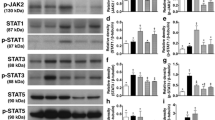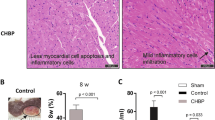Summary
It has been well established that erythropoietin (EPO) can limit myocardial ischemia/reperfusion injury in a variety of acute settings. However, despite EPO being used chronically to treat anemia the infarct limiting effects of long term treatment (chronic) have never been fully investigated. In this study we examined the effects of a 3 week treatment of EPO (5,000 IU/Kg) in male Sprague Dawley rats in limiting myocardial infarction after 35 min ischemia and 2 h reperfusion in an in vitro isolated heart perfusion model. Treating the animals ‘once a week’ failed to limit infarct size significantly compared to a saline control (54.1% ± 3.5 v 52.3% ± 4.4), whereas a ‘3 times a week’ regime succeeded in significantly reducing infarct size (36.2% ± 3.2 v 52.3% ± 4.4, p < 0.05). To demonstrate that the effect was not due to improved oxygen supply caused by a raised hematocrit level, we also administered EPO 24 h prior to ischemia/reperfusion. This treatment again reduced infarct size compared to a saline control (39.9% ± 4.4 v 58.4% ± 5.0, p < 0.05). To examine the mechanism of protection we used the PI3K inhibitor wortmannin and the nitric oxide synthase inhibitor L-NAME to try to abrogate EPO mediated protection. Where wortmannin failed to block the effects of EPO (31.7% ± 6.0 v 36.2% ± 3.2), L-NAME did abrogate protection (51.6% ± 5.6 v 36.2% ± 3.2, p < 0.05). We demonstrate that chronic EPO treatment limits infarct size and that it does so in a nitric oxide dependent manner.
Similar content being viewed by others
References
Mancini DM, Katz SD, Lang CC, LaManca J, Hudaihed A, Androne AS. Effect of erythropoietin on exercise capacity in patients with moderate to severe chronic heart failure. Circulation 2003;107:294–299.
Calvillo L, Latini R, Kajstura J, et al. Recombinant human erythropoietin protects the myocardium from ischemia-reperfusion injury and promotes beneficial remodeling. Proc Natl Acad Sci USA 2003;100:4802–4806.
Junk AK, Mammis A, Savitz SI, et al. Erythropoietin administration protects retinal neurons from acute ischemia-reperfusion injury. Proc Natl Acad Sci USA 2002;99:10659–10664.
Ruscher K, Freyer D, Karsch M, et al. Erythropoietin is a paracrine mediator of ischemic tolerance in the brain: Evidence from an in vitro model. J Neurosci 2002;22:10291–10301.
Fiordaliso F, Chimenti S, Staszewsky L, et al. A nonerythropoietic derivative of erythropoietin protects the myocardium from ischemia-reperfusion injury. Proc Natl Acad Sci USA 2005;102:2046–2051.
Wang X, Zhu C, Wang X, et al. The nonerythropoietic asialoerythropoietin protects against neonatal hypoxia-ischemia as potently as erythropoietin. J Neurochem 2004;91:900–910.
Abdelrahman M, Sharples EJ, McDonald MC, et al. Erythropoietin attenuates the tissue injury associated with hemorrhagic shock and myocardial ischemia. Shock 2004;22:63–69.
Lipsic E, van der MP, Henning RH, et al. Timing of erythropoietin treatment for cardioprotection in ischemia/reperfusion. J Cardiovasc Pharmacol 2004;44:473–479.
Bullard AJ, Govewalla P, Yellon DM. Erythropoietin protects the myocardium against reperfusion injury in vitro and in vivo. Basic Res Cardiol 2005.
Hausenloy DJ and Yellon DM. New directions for protecting the heart against ischaemia-reperfusion injury: Targeting the Reperfusion Injury Salvage Kinase (RISK)-pathway. Cardiovasc Res 2004;61:448–460.
Hirata A, Minamino T, Asanuma H, et al. Erythropoietin just before reperfusion reduces both lethal arrhythmias and infarct size via the phosphatidylinositol-3 kinase-dependent pathway in canine hearts. Cardiovasc Drugs Ther 2005;19:33–40.
Parsa CJ, Matsumoto A, Kim J, et al. A novel protective effect of erythropoietin in the infarcted heart. J Clin Invest 2003;112:999–1007.
Tramontano AF, Muniyappa R, Black AD, et al. Erythropoietin protects cardiac myocytes from hypoxia-induced apoptosis through an Akt-dependent pathway. Biochem Biophys Res Commun 2003;308:990–994.
Andjelkovic M, Jakubowicz T, Cron P, Ming XF, Han JW, Hemmings BA. Activation and phosphorylation of a pleckstrin homology domain containing protein kinase (RAC-PK/PKB) promoted by serum and protein phosphatase inhibitors. Proc Natl Acad Sci USA 1996;93:5699–5704.
Gao T, Furnari F, Newton AC. PHLPP: A phosphatase that directly dephosphorylates Akt, promotes apoptosis, and suppresses tumor growth. Mol Cell 2005;18:13–24.
Gao F, Gao E, Yue TL, et al. Nitric oxide mediates the antiapoptotic effect of insulin in myocardial ischemia-reperfusion: The roles of PI3-kinase, Akt, and endothelial nitric oxide synthase phosphorylation. Circulation 2002;105:1497–1502.
Hanlon PR, Fu P, Wright GL, Steenbergen C, Arcasoy MO, Murphy E. Mechanisms of erythropoietin-mediated cardioprotection during ischemia-reperfusion injury: Role of protein kinase C and phosphatidylinositol 3-kinase signaling. Faseb J 2005;19:1323–1325.
Banerjee D, Rodriguez M, Nag M, Adamson JW. Exposure of endothelial cells to recombinant human erythropoietin induces nitric oxide synthase activity. Kidney Int 2000;57:1895–1904.
Gonzales GF, Chung FA, Miranda S, et al. Heart mitochondrial nitric oxide synthase is upregulated in male rats exposed to high altitude (4,340 m). Am J Physiol Heart Circ Physiol 2005;288:H2568–H2573.
Bell RM, Smith CC, Yellon DM: Nitric oxide as a mediator of delayed pharmacological (A(1) receptor triggered) preconditioning; is eNOS masquerading as iNOS? Cardiovasc Res 2002;53:405–413.
Wang G, Liem DA, Vondriska TM, et al. Nitric oxide donors protect murine myocardium against infarction via modulation of mitochondrial permeability transition. Am J Physiol Heart Circ Physiol 2005;288:H1290–H1295.
Shi Y, Rafiee P, Su J, Pritchard KA, Jr., Tweddell JS, Baker JE: Acute cardioprotective effects of erythropoietin in infant rabbits are mediated by activation of protein kinases and potassium channels. Basic Res Cardiol 2004;99:173–182.
Xu B, Dong GH, Liu H, Wang YQ, Wu HW, Jing H. Recombinant human erythropoietin pretreatment attenuates myocardial infarct size: A possible mechanism involves heat shock Protein 70 and attenuation of nuclear factor-kappaB. Ann Clin Lab Sci 2005;35: 161–168.
Brines M, Grasso G, Fiordaliso F, et al. Erythropoietin mediates tissue protection through an erythropoietin and common beta-subunit heteroreceptor. Proc Natl Acad Sci USA 2004;101:14907–14912.
Author information
Authors and Affiliations
Corresponding author
Rights and permissions
About this article
Cite this article
Bullard, A.J., Yellon, D.M. Chronic Erythropoietin Treatment Limits Infarct-size in the Myocardium in Vitro. Cardiovasc Drugs Ther 19, 333–336 (2005). https://doi.org/10.1007/s10557-005-4595-5
Issue Date:
DOI: https://doi.org/10.1007/s10557-005-4595-5




